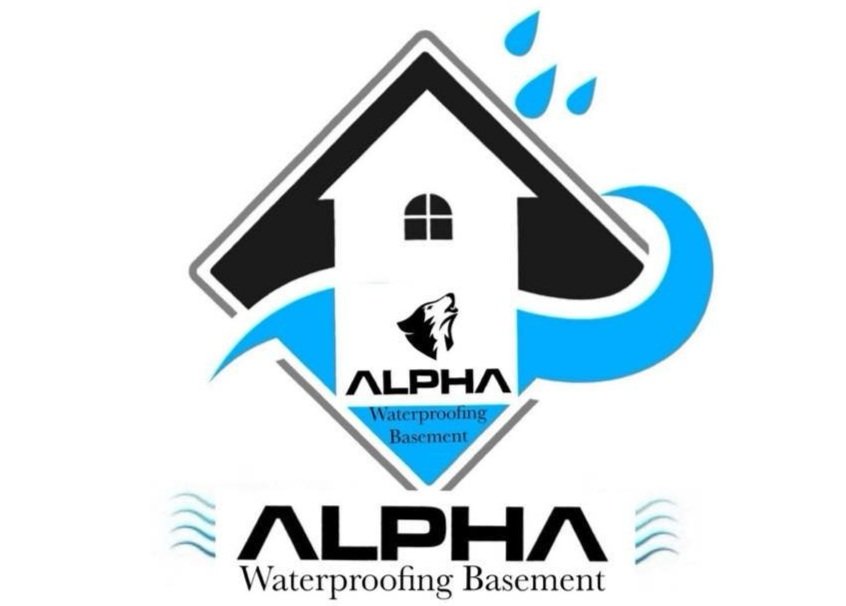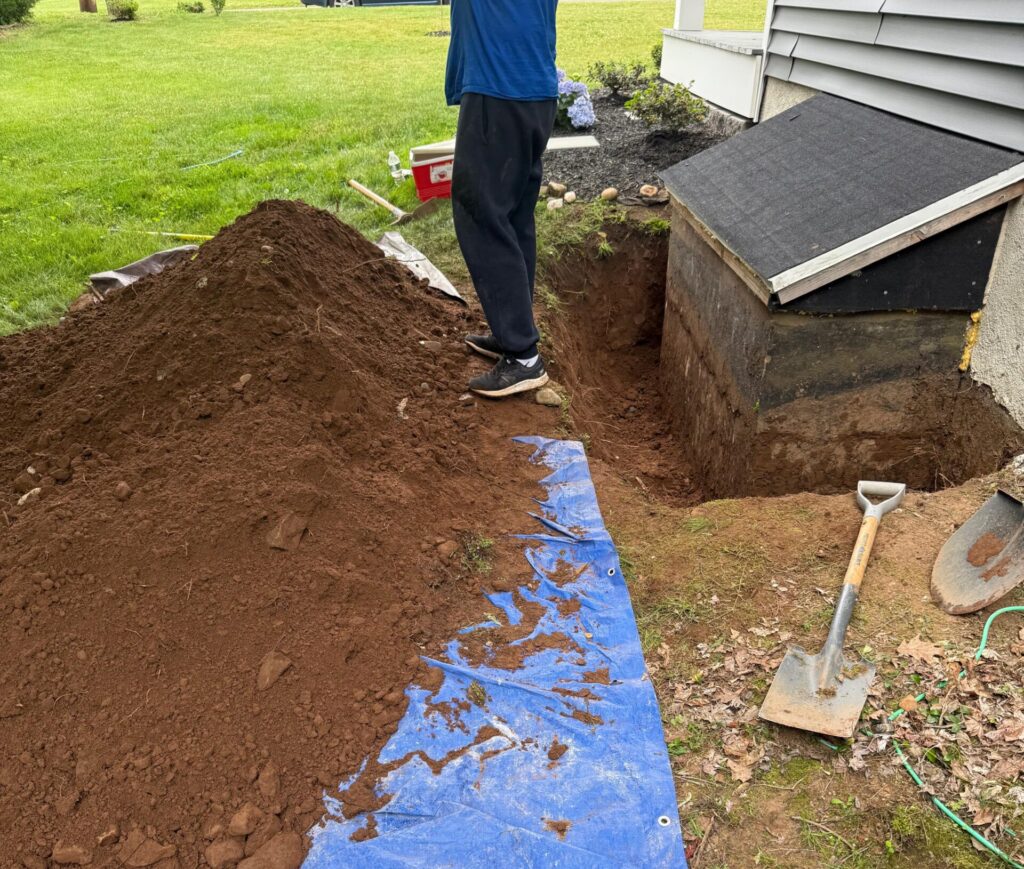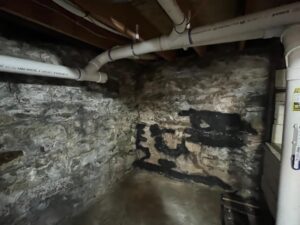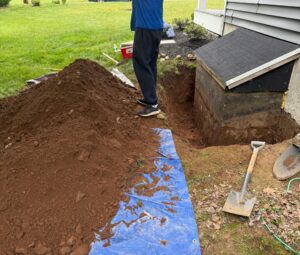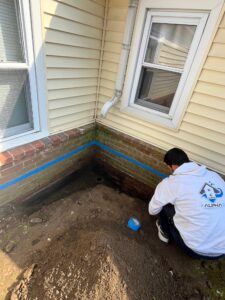You can waterproof a basement by sealing walls, floors, and foundations using interior and exterior methods. But the proper method depends on your home’s condition, budget, and water problem.
Your basement can be super handy; extra storage, laundry spot, or a chill hangout space.
But if water sneaks in? Total nightmare. Damp walls, ruined stuff, and gross mold that messes with your health.
The fix? Waterproofing. It keeps your basement dry, safe, and usable instead of a musty dungeon.
First Things First: What are the Types of Basement Waterproofing?
Not every basement has the same water problem. Some only feel slightly damp, while others face heavy leaks or flooding. That’s why there are different waterproofing methods:
- Interior Sealants: Paint-like coatings for inside walls. Suitable for light dampness, but not for heavy leaks.
- Exterior Membranes: Waterproof layers applied outside the foundation. Costly but very effective for long-term protection.
- Drainage Systems: Pipes or channels inside or outside that move water away, often connected to a sump pump.
- Sump Pumps: a pit built into the basement floor. Its job is simple: gather any water that collects there and push it out of your home.
- Vapor Barriers: Plastic or foil sheets that block moisture in finished basements, protecting floors and walls.
NEXT: Which interior basement waterproofing products should you use?
Some commonly used products include:
- Drylok or Xypex waterproof paint
- Liquid rubber membranes
- Hydraulic cement (for cracks)
- Vapor barriers (plastic sheets for walls/floors)
- Sump pumps and drainage systems
Always choose products based on your water problem. For example, paint alone won’t solve flooding, but it works fine for mild dampness.
How do you waterproof basement walls from the inside?
Interior waterproofing protects the inside of your basement. It won’t stop water from touching the outer walls, but it does block moisture from sneaking into your living space.
Steps:
- Clean the walls: Remove paint, dirt, and loose concrete.
- Seal cracks: Fill up any cracks with hydraulic cement. It swells as it dries, sealing the gap tightly so water can’t get through again.
- Apply a waterproof coating: Use products like waterproofing paint or liquid membranes. These create a moisture barrier.
- Install an interior drainage system: For bigger problems, sump pumps and drainage channels can help direct water out.
This method works best for minor leaks, dampness, or condensation issues. It’s usually cheaper and easier than exterior work.
How to Waterproof a Basement from the Outside?
Exterior waterproofing tackles the problem right at the source. It costs more and usually means digging around your foundation, but the payoff is a strong, long-lasting fix.
Steps:
- Excavate around the foundation: The soil around the house is removed to uncover the basement walls.
- Clean and repair walls: Any cracks are sealed with waterproof materials like sealant or hydraulic cement.
- Apply waterproof membranes: A thick coating or sheet membrane is applied to stop water penetration.
- Install drainage system: A French drain or weeping tile system is placed at the base to carry water away.
- Backfill with gravel and soil helps water move away from the foundation.
This method is ideal if your basement suffers from constant water seepage or if the house is in a high-water table area.
How to Waterproof a Basement Floor?
Basement floors often absorb moisture through capillary action from the soil beneath.
Ways to waterproof a basement floor:
- Seal cracks with epoxy or hydraulic cement.
- Apply concrete sealers that block water penetration.
- Install a vapor barrier beneath the flooring if you plan to finish the basement.
- Consider interior drainage if water pressure builds under the slab.
For example, if your basement floor shows white chalky stains (called efflorescence), that’s a sign water is seeping in slowly. A concrete sealer can help.
DIY Basement Waterproofing: Can You Do That?
Yes, you can handle some waterproofing tasks independently, especially if your basement only has light dampness. Common DIY steps include:
- Sealing small cracks with hydraulic cement or epoxy.
- Applying waterproof paint or coatings on interior walls.
- Installing vapor barriers on walls or under flooring to block moisture.
These are simple and cost-effective fixes for minor problems.
However, larger projects should be left to professionals, such as:
- Installing interior or exterior drainage systems,
- Setting up sump pumps, or
- Excavating around the foundation,
These jobs are more complex, and mistakes can cause serious water damage or lead to higher repair costs in the future.
How Much Would it Cost to Waterproof Basement Walls from Inside?
The price can vary based on your basement’s size and the severity of the issue.
- Interior sealants/paints: $300–$1,000 for DIY projects.
- Interior drainage system with sump pump: $2,000–$7,000.
- Exterior waterproofing: $8,000–$15,000 or more, depending on excavation depth.
A full waterproofing job for a 1500 sq ft basement can easily cost between $5,000 and $12,000.
Final Thoughts
For small issues, you can manage with DIY fixes like sealing cracks or adding a coating. But if water keeps coming back or the damage feels serious, it’s best to call experts.
Contact Alpha Waterproofing today to protect your basement with reliable solutions that last.
People Also Ask
Can I waterproof my basement myself?
You can tackle small jobs yourself, like sealing cracks or painting on a waterproof coat. But if you’re dealing with heavy leaks or flooding, it’s best to call in the pros.
What is the best waterproofing method for a basement?
Waterproofing from the outside with drains and membranes is the strongest, longest-lasting fix. Still, interior methods can be a more budget-friendly choice if you’re only dealing with small problems.
Can you waterproof your basement from the inside?
Yes, interior fixes like sealants, sump pumps, and drains are great for handling dampness and minor leaks. They won’t keep water from touching the walls, but they do stop it from getting into your basement.
How much does it cost to waterproof a 1500 sq ft basement?
On average, waterproofing a 1500 sq ft basement costs between $5,000–$12,000, depending on whether you choose interior or exterior methods.
